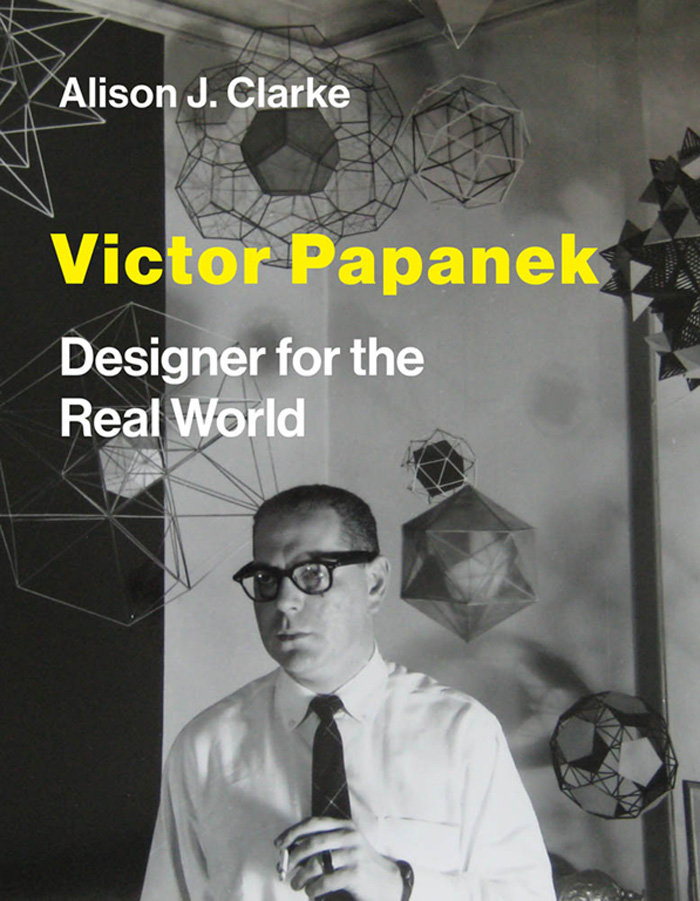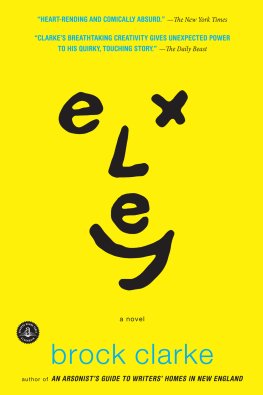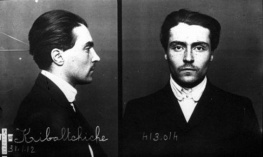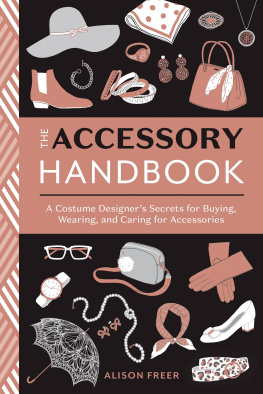Alison J. Clarke - Victor Papanek: Designer for the Real World
Here you can read online Alison J. Clarke - Victor Papanek: Designer for the Real World full text of the book (entire story) in english for free. Download pdf and epub, get meaning, cover and reviews about this ebook. year: 2021, publisher: MIT Press, genre: Detective and thriller. Description of the work, (preface) as well as reviews are available. Best literature library LitArk.com created for fans of good reading and offers a wide selection of genres:
Romance novel
Science fiction
Adventure
Detective
Science
History
Home and family
Prose
Art
Politics
Computer
Non-fiction
Religion
Business
Children
Humor
Choose a favorite category and find really read worthwhile books. Enjoy immersion in the world of imagination, feel the emotions of the characters or learn something new for yourself, make an fascinating discovery.

- Book:Victor Papanek: Designer for the Real World
- Author:
- Publisher:MIT Press
- Genre:
- Year:2021
- Rating:3 / 5
- Favourites:Add to favourites
- Your mark:
- 60
- 1
- 2
- 3
- 4
- 5
Victor Papanek: Designer for the Real World: summary, description and annotation
We offer to read an annotation, description, summary or preface (depends on what the author of the book "Victor Papanek: Designer for the Real World" wrote himself). If you haven't found the necessary information about the book — write in the comments, we will try to find it.
Victor Papanek: Designer for the Real World — read online for free the complete book (whole text) full work
Below is the text of the book, divided by pages. System saving the place of the last page read, allows you to conveniently read the book "Victor Papanek: Designer for the Real World" online for free, without having to search again every time where you left off. Put a bookmark, and you can go to the page where you finished reading at any time.
Font size:
Interval:
Bookmark:

Alison J. Clarke
The MIT Press
Cambridge, Massachusetts
London, England
2021 Alison J. Clarke
All rights reserved. No part of this book may be reproduced in any form by any electronic or mechanical means (including photocopying, recording, or information storage and retrieval) without permission in writing from the publisher.
This book was set in ITC Stone Serif Std and ITC Stone Sans Std by New Best-set Typesetters Ltd.
Library of Congress Cataloging-in-Publication Data
Names: Clarke, Alison J., author.
Title: Victor Papanek : designer for the real world / Alison J. Clarke.
Description: Cambridge, Massachusetts : The MIT Press, [2021] | Includes bibliographical references and index.
Identifiers: LCCN 2020015192 | ISBN 9780262044943 (hardcover)
Subjects: LCSH: Papanek, Victor J. | Papanek, Victor J.Influence. | Industrial designersUnited StatesBiography. | Industrial designSocial aspects.
Classification: LCC TS140.P28 C59 2021 | DDC 745.2dc23
LC record available at https://lccn.loc.gov/2020015192
10987654321
d_r0
For Constance Loadwick & Solomon Charles
The breadth of archival and oral history research, spanning several years, that underpins this monograph was made possible through the support of the Botstiber Institute for Austrian-American Studies, and the Fonds zur Frderung der wissenschaftlichen Forschung (FWF, Austria), for which I am enormously thankful. I gratefully acknowledge the support of The Graham Foundation in enabling the production of this book.
At various points my research took me to Northern Europe, North America, South America, and South Asia. This work depended as much on the oral histories and insights individuals shared with enthusiasm and critical perspective as it did on archival and visual documentation. Their experiences as colleagues, students, and friends of Victor Papanek, and their own involvement with design activism in the 1960s and 1970s, proved invaluable to the project and its critical framing. Some of those individuals preferred to remain anonymous; I thank them, and the following people: Olli Alho, Maria Benktzon, Pak Imam Buchori, Steen Juhler, Goroslav Keller, Barbro Kulvik, Satish Kumar, Gunilla Lindahl, Peter Mackeprang, Per Mollerup, Vuokko Nurmesniemi, Dieter Raffler, Mohd Azali Abd. Rahim, M. P. Ranjan, Parko Severi, Antti Siltavuori, Howard Smith, Liisa Tenkku, Lise Lotte Wiingaard.
Exceptional thanks are due to Mikko Pyhl, author and former Finnish diplomat, who provided strong support for the project through his own personal perspective on Papanek and the 1960s in Finnish history and his tireless direction to appropriate resources and oral history contacts. Jim Hennessey, lifelong friend, collaborator, and coauthor with Papanek, along with Sara Hennessey were extremely generous with their time and sources. Yrj Sotamaa, prominent design educator and former colleague of Papanek at Purdue University in the late 1960s, has been an abiding supporter of the research into the origins of social design. Investigating industrial design during this period, despite the number of women involved as students or tutors, is fraught with the methodological issue of representing womens largely undocumented presence. Sheila Levrant de Bretteville, a colleague and critic of Papanek during his deanship at CalArts (California Institute of the Arts), generously gave of her time discussing the pedagogic approach of design activism from a personal as well as historical feminist perspective. Gui Bonsiepe, leading design theorist and critic of Papaneks ideas around development in the Global South through the 1960s and 1970s, offered hours of interviews in his home in La Plata, Argentina, and proved to be a welcome ally in exploring the problematic dimensions of design for the real world. Friends and family of Papanek provided detailed context and more intimate perspectives on his work and life: Thanks to Nicolette Papanek, Harlanne Roberts, Jennifer Satu, and Al Gowan.
The nuanced translation of key documents and transcripts from Finnish, Swedish, Danish, and Norwegian proved pivotal to the project. In this respect, I am particularly grateful to David Jones and Jyri Kokkonen. As well as providing translations, Robert Gassner shared his unbridled enthusiasm for primary research and his extensive knowledge made research in Denmark enormous fun. Thanks to Michael Pierazzi in San Francisco and Jennifer Kaufmann at Purdue University, as well as amateur genealogist Michael Foster, all of whom generously provided local research materials and insights. Bart Beaty shared nuanced insights from his extensive research on Fredric Wertham that proved vital to understanding the impact of 1940s social psychiatry on Papaneks anticonsumerist discourse. Fiona Raby, Jamer Hunt, Paola Antonelli, and John Thackarathrough engagement with the materials in various contexts from exhibitions to symposiahave offered great insights. Historian Felicity D. Scott and anthropologist Arturo Escobar helped shape my thinking through their own work and early related discussions. Thanks also to Tanishka Kachru and Carey Hedlund. Undoubtedly, I have inadvertently omitted numerous other individuals integral to this project, and for this I apologize unreservedly.
The following institutions, archives, and libraries and their teams offered vital input to a research project that spanned several years. My thanks go to the Avery Architectural and Fine Arts Library, Columbia University, New York; CalArts Library, Special Collections and Institute Archives, Valencia, California; Frank Lloyd Wright Foundation, Scottsdale, Arizona; Freningen Svensk Form, Historical Centre for Business History, Stockholm, Sweden; Archive and Library, Konstfack, Stockholm, Sweden; National Institute of Design, Archive and Library, Ahmedabad, India; Hagley Museum and Library, Wilmington, Delaware; University of Jyvskyl Archive and Library, Jyvskyl, Finland; International Institute of Social History, Amsterdam, Netherlands; Museum of the City of New York, New York; NC State University Libraries, Special Collections, Raleigh, North Carolina; Jane Kessler Memorial Archives, Penland School of Craft, Penland, North Carolina; Parsons New School of Design, Archive and Library, New York; Cooper Union, Archive and Library, New York; Purdue University Archives and Special Collections, West Lafayette, Indiana; Visual Resources and Special Collections, Dorothy H. Hoover Library, OCAD University Archives, Toronto; Schumacher College, Devon, UK: San Francisco Public Library, newspaper collection, San Francisco, California; UC Berkeley Library, University Archives, Berkeley, California; United Nations International Development Organization (UNIDO), Vienna; University of Brighton Design Archives, UK; Volvo Museum, Gothenburg, Sweden.
The Victor J. Papanek Foundation archive at the University of Applied Arts Vienna formed the initial locus of my research. The collection was first painstakingly collated by architectural historian Bryleigh Morsink. My great thanks go to Bryleigh, an inspired researcher, with whom I spent many an hour in the early stages of research mapping out Papaneks US residences and various biographical timelines. Thanks to my colleagues Martina Gruenewald and Elana Shapira for sharing numerous fruitful research conversations, and to Michelle Jackson-Beckett for her invaluable insight. Heartfelt thanks to Maria Blyzinsky for her abiding friendship and to the Nenning family. I am grateful to Mateo Kries at Vitra Design Museum, Germany, and the curatorial team there, who enthusiastically embraced my suggestion to co-curate an international traveling exhibition exploring Papaneks ideas in relation to contemporary design practice, and the contradictions of design activism shaped by the historical research for this book.
Next pageFont size:
Interval:
Bookmark:
Similar books «Victor Papanek: Designer for the Real World»
Look at similar books to Victor Papanek: Designer for the Real World. We have selected literature similar in name and meaning in the hope of providing readers with more options to find new, interesting, not yet read works.
Discussion, reviews of the book Victor Papanek: Designer for the Real World and just readers' own opinions. Leave your comments, write what you think about the work, its meaning or the main characters. Specify what exactly you liked and what you didn't like, and why you think so.








